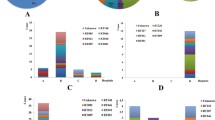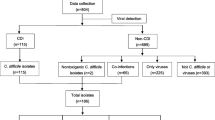Abstract
Patients hospitalized in a hospital with a high incidence of antibiotic-associated diarrhea due to toxin A-negative, toxin B-positive (A−/B+) Clostridium difficile were retrospectively investigated to determine the clinical manifestations and risk factors for infection. Of 77 Clostridium difficile isolates obtained from 77 patients during the 1-year investigation period, 30 were A−/B+ and 47 were toxin A-positive, toxin B-positive (A+/B+). By pulsed-field gel electrophoresis analysis, 23 of the 30 A−/B+ strains were outbreak-related, suggesting nosocomial spread of a single type of bacterium, which mainly affected patients in the wards of respiratory medicine, hematology and neurology. Using regression analysis, three factors were found to be associated with infection by A−/B+ isolates: (i) exposure to antineoplastic agents (P=0.01, odds ratio [OR]=5.1), (ii) the use of nasal feeding tubes (P=0.008, OR=5.2), and (iii) assignment to a certain internal medicine ward (P=0.05, OR=3.0). Between patients with Clostridium difficile-associated diarrhea caused by A−/B+ strains and those with A+/B+ strains, no statistically significant difference was found in body temperature, serum concentration of C-reactive protein, leukocyte count in whole blood, frequency of diarrhea, or type of underlying disease. These results indicate that A−/B+ strains of Clostridium difficile can cause intestinal infection in humans and they spread nosocomially in the same manner as A+/B+ strains.

Similar content being viewed by others
References
Clabots CR, Johnson S, Olson MM, Peterson LR, Gerding DN (1992) Acquisition of Clostridium difficile by hospitalized patients: evidence for colonized new admissions as a source of infection. J Infect Dis 166:561–567
Johnson S, Gerding DN (1992) Clostridium difficile-associated diarrhea. Clin Infect Dis 26:1027–1036
Lai KK, Melvin ZS, Menard MJ, Kotilainen HR, Baker S (1997) Clostridium difficile-associated diarrhea: epidemiology, risk factors, and infection control. Infect Control Hosp Epidemiol 18:628–632
Borriello SP, Wren BW, Hyde S, Seddon SV, Sibbons P, Krishna MM, Tabaqchali S, Manek S, Price AB (1992) Molecular, immunological, and biological characterization of a toxin A-negative, toxin B-positive strain of Clostridium difficile. Infect Immun 60:4192–4199
Lyerly DM, Barroso LA, Wilkins TD, Depitre C, Corthier G (1992) Characterization of a toxin A-negative, toxin B-positive strain of Clostridium difficile. Infect Immun 60:4633–4639
Depitre C, Delmee M, Avesani V, L'Haridon R, Roels A, Popoff M, Corthier G (1993) Serogroup F strains of Clostridium difficile produce toxin B but not toxin A. J Med Microbiol 38:434–441
Alfa MJ, Kabani A, Lyerly D, Moncrief S, Neville LM, Al-Barrak A, Harding GK, Dyck B, Olekson K, Embil JM (2000) Characterization of a toxin-A-negative, toxin-B-positive strain of Clostridium difficile responsible for a nosocomial outbreak of Clostridium difficile-associated diarrhea. J Clin Microbiol 38:2706–2714
Limaye AP, Turgeon DK, Cookson BT, Fritsche TR (2000) Pseudomembranous colitis caused by a toxin A−B+ strain of Clostridium difficile. J Clin Microbiol 38:1696–1697
Kuijper EJ, de Weerdt J, Kato H, Kato N, van Dam AP, van der Vorm ER, Weel J, van Rheenen C, Dankert J (2001) Nosocomial outbreak of Clostridium difficile-associated diarrhoea due to a clindamycin-resistant, enterotoxin A-negative strain. Eur J Clin Microbiol Infect Dis 20:528–534
O'Connor D, Hynes P, Cormican M, Collins E, Corbett-Feeney G, Cassidy M (2001) Evaluation of methods for detection of toxins in specimens of feces submitted for diagnosis of Clostridium difficile-associated diarrhea. J Clin Microbiol 39:2846–2849
Borriello SP, Honour P (1981) Simplified procedure for routine isolation of Clostridium difficile from faeces. J Clin Pathol 34:1124–1127
Allen SD, Emery CL, Siders JA (1999) Clostridium. In: Murray PR, Baron EJ, Pfaller MA, Tenover FC, Yolken RH (eds) Manual of clinical microbiology, 7th edn. American Society for Microbiology, Washington, DC, pp 654–671
Kato H, Kato N, Watanabe K, Iwai N, Nakamura H, Yamamoto T, Suzuki K, Kim SM, Chong Y, Wasito EB (1998) Identification of toxin A-negative, toxin B-positive Clostridium difficile by PCR. J Clin Microbiol 36:2178–2182
Kato H, Kato N, Watanabe K, Ueno K, Ushijima H, Hashira S, Abe T (1994) Application of typing by pulsed-field gel electrophoresis to the study of Clostridium difficile in a neonatal intensive care unit. J Clin Microbiol 32:2067–2070
Tenover FC, Arbeit RD, Goering RV, Mickelsen PA, Murray BE, Persing DH, Swaminathan B (1995) Interpreting chromosomal DNA restriction patterns produced by pulsed-field gel electrophoresis: criteria for bacterial strain typing. J Clin Microbiol 33:2233–2239
Kato H, Kato N, Katow S, Maegawa T, Nakamura S, Lyerly DM (1999) Deletions in the repeating sequences of the toxin A gene of toxin A-negative, toxin B-positive Clostridium difficile strains. FEMS Microbiol Lett 175:197–203
Kato H, Kato N, Watanabe K, Yamamoto T, Suzuki K, Ishiguro S, Kunihiro S, Nakamura I, Killgore GE, Nakamura S (2001) Analysis of Clostridium difficile isolates from nosocomial outbreaks at three hospitals in diverse areas of Japan. J Clin Microbiol 39:1391–1395
Brazier JS, Stubbs SL, Duerden BI (1999) Prevalence of toxin A negative/B positive Clostridium difficile strains. J Hosp Infect 42:248–249
Pituch H, van den Braak N, van Leeuwen W, van Belkum A, Martirosian G, Obuch-Woszczatynski P, Luczak M, Meisel-Mikolajczyk F (2001) Clonal dissemination of a toxin-A-negative/toxin-B-positive Clostridium difficile strain from patients with antibiotic-associated diarrhea in Poland. Clin Microbiol Infect 7:442–446
Al-Barrak A, Embil J, Dyck B, Olekson K, Nicoll D, Alfa M, Kabani A (1999) An outbreak of toxin A negative, toxin B positive Clostridium difficile-associated diarrhea in a Canadian tertiary-care hospital. Can Commun Dis Rep 25:65–69
Bliss DZ, Johnson S, Savik K, Clabots CR, Willard K, Gerding DN (1998) Acquisition of Clostridium difficile and Clostridium difficile-associated diarrhea in hospitalized patients receiving tube feeding. Ann Intern Med 129:1012–1019
Anand A, Glatt AE (1993) Clostridium difficile infection associated with antineoplastic chemotherapy: a review. Clin Infect Dis 17:109–113
Author information
Authors and Affiliations
Corresponding author
Rights and permissions
About this article
Cite this article
Komatsu, M., Kato, H., Aihara, M. et al. High Frequency of Antibiotic-Associated Diarrhea due to Toxin A-Negative, Toxin B-Positive Clostridium difficile in a Hospital in Japan and Risk Factors for Infection. Eur J Clin Microbiol Infect Dis 22, 525–529 (2003). https://doi.org/10.1007/s10096-003-0992-5
Published:
Issue Date:
DOI: https://doi.org/10.1007/s10096-003-0992-5




